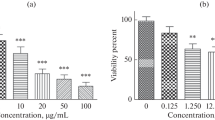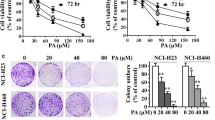Abstract
Lung cancer is the leading cause of cancer-related deaths worldwide. Cisplatin-based chemotherapy remains the standard gold method in therapeutic strategy due to the high usefulness of cisplatin, the application, and the dosage of cisplatin regulated by its adverse effects on neurons. In addition, salicylic acid as a nonsteroidal anti-inflammatory drug has also been reported to treat another type of cancer by activating apoptosis mechanisms. In this research, the synergistic function of cisplatin and salicylic acid on apoptosis activity, cytotoxicity of lung cell lines A549 and Calu-6, and molecular expression level of ZEB1 and P21 genes were the main objectives. Lung carcinoma cell lines A549 and Calu-6 were exposed to different concentrations of cisplatin and salicylic acid alone and in combination to evaluate cell viability by MTT assay. Then, the optimal concentration of cisplatin (0.5 µM) in combination with salicylic acid (2 mM) for apoptotic cells was determined by flow cytometry. Real-time PCR was also performed to conduct the expression analysis of P21 and ZEB1 genes. The combination of the two drugs showed the highest inhibitory and anti-proliferation effects on A549 and Calu-6 cell lines (P ˂ 0.05; P ˂ 0.01, respectively). Gene expression analysis showed that the P21 gene was significantly downregulated in the Calu-6 cell lines and the ZEB1 gene was downregulated only in the A549 cell line (P = 0.01). ZEB1 was overexpressed in the Calu-6. The combined form of cisplatin and salicylic acid significantly suppressed cell proliferation and promoted apoptosis in lung cancer cell lines.





Similar content being viewed by others
Data availability
All raw data are obtained from devices and presented in GraphPad prism software.
Code availability
Not applicable.
Abbreviations
- A549:
-
Lung cancer cell line
- Calu-6:
-
Lung cancer cell line
- DMEM:
-
Dulbecco’s Modified Eagle’s Medium
- FBS:
-
Fetal bovine serum
- IC50:
-
The half-maximal inhibitory concentration
- MTT:
-
3-[4,5-dimethylthiazol-2-yl]-2,5-diphenyltetrazolium bromide
- OD:
-
Optical density
- PBS:
-
Phosphate buffered saline
- PI:
-
Propidium iodide
- RT-PCR:
-
Real-time PCR
- DMSO:
-
Dimethylsulfoxide
- GAPDH:
-
Glyceraldehyde 3-phosphate dehydrogenase
- V-FITC:
-
V-Fluorescein isothiocyanate
References
Amable L (2016) Cisplatin resistance and opportunities for precision medicine. Pharmacol Res 106:27–36. https://doi.org/10.1016/j.phrs.2016.01.001
Andriani F, Perego P, Carenini N, Sozzi G, Roz L (2006) Increased sensitivity to cisplatin in non-small cell lung cancer cell lines after FHIT gene transfer. Neoplasia 8:9–17. https://doi.org/10.1593/neo.05517
Bar J, Gorn-Hondermann I, Moretto P, Perkins TJ, Niknejad N, Stewart DJ, Goss GD, Dimitroulakos J (2015) miR profiling identifies cyclin-dependent kinase 6 downregulation as a potential mechanism of acquired cisplatin resistance in non-small-cell lung carcinoma. Clin Lung Cancer 16:e121–e129. https://doi.org/10.1016/j.cllc.2015.01.008
Brambilla E, Gazdar AF (2009) Pathogenesis of lung cancer signalling pathways: Roadmap for therapies. Eur Respir J 33:1485–1497. https://doi.org/10.1183/09031936.00014009
Bray F, Ferlay J, Soerjomataram I, Siegel RL, Torre LA, Jemal A (2018) Global cancer statistics 2018: GLOBOCAN estimates of incidence and mortality worldwide for 36 cancers in 185 countries. CA Cancer J Clin 68:394–424. https://doi.org/10.3322/caac.21492
Canel M, Serrels A, Frame MC, Brunton VG (2013) E-cadherin-integrin crosstalk in cancer invasion and metastasis. J Cell Sci 126:393–401. https://doi.org/10.1242/jcs.100115
Cui Y, Qin L, Tian D, Wang T, Fan L, Zhang P, Wang Z (2018) ZEB1 Promotes Chemoresistance to Cisplatin in Ovarian Cancer Cells by Suppressing SLC3A2. Chemotherapy 63:262–271. https://doi.org/10.1159/000493864
Dasari S, Tchounwou PB (2014) Cisplatin in cancer therapy: Molecular mechanisms of action. Eur J Pharmacol 740:364–378. https://doi.org/10.1016/j.ejphar.2014.07.025
Denizot F, Lang R (1986) Rapid colorimetric assay for cell growth and survival. Modifications to the tetrazolium dye procedure giving improved sensitivity and reliability. J Immunol Methods 89:271–277. https://doi.org/10.1016/0022-1759(86)90368-6
Elwood PC, Gallagher AM, Duthie GG, Mur LA, Morgan G (2009) Aspirin, salicylates, and cancer. Lancet 373:1301–1309. https://doi.org/10.1016/S0140-6736(09)60243-9
Gazdar AF, Brambilla E (2011) Preneoplasia of lung cancer. Cancer Biomark 9:385–396. https://doi.org/10.3233/CBM-2011-0166
Gemmill RM, Roche J, Potiron VA, Nasarre P, Mitas M, Coldren CD, Helfrich BA, Garrett-Mayer E, Bunn PA, Drabkin HA (2011) ZEB1-responsive genes in non-small cell lung cancer. Cancer Lett 300:66–78. https://doi.org/10.1016/j.canlet.2010.09.007
Ghobrial IM, Witzig TE, Adjei AA (2005) Targeting apoptosis pathways in cancer therapy. CA Cancer J Clin 55:178–194. https://doi.org/10.3322/canjclin.55.3.178
Huang CS, Huang AC, Huang PH, Lo D, Wang YT, Wu MC (2018) Synergistic antitumor effect of oligogalacturonides and cisplatin on human lung cancer A549 cells. Int J Mol Sci 19(6). https://doi.org/10.3390/ijms19061769
Jana NR (2008) NSAIDs and apoptosis. Cell Mol Life Sci 65:1295–1301. https://doi.org/10.1007/s00018-008-7511-x
Kwan YP, Saito T, Ibrahim D, Al-Hassan FMS, Ein Oon C, Chen Y, Jothy SL, Kanwar JR, Sasidharan S (2016) Evaluation of the cytotoxicity, cell-cycle arrest, and apoptotic induction by Euphorbia hirta in MCF-7 breast cancer cells. Pharm Biol 54:1223–1236. https://doi.org/10.3109/13880209.2015.1064451
Larsen JE, Nathan V, Osborne JK, Farrow RK, Deb D, Sullivan JP, Dospoy PD, Augustyn A, Hight SK, Sato M, Girard L, Behrens C, Wistuba II, Gazdar AF, Hayward NK, Minna JD (2016) ZEB1 drives epithelial-to-mesenchymal transition in lung cancer. J Clin Invest 126:3219–3235. https://doi.org/10.1172/JCI76725
Lincet H, Poulain L, Remy JS, Deslandes E, Duigou F et al (2000) The p21(cip1/waf1) cyclin-dependent kinase inhibitor enhances the cytotoxic effect of cisplatin in human ovarian carcinoma cells. Cancer Lett 161:17–26. https://doi.org/10.1016/s0304-3835(00)00586-3
Murphy NR, Hellwig RJ (1996) Improved nucleic acid organic extraction through use of a unique gel barrier material. Biotechniques 21:934–939. https://doi.org/10.2144/96215pf01
Maddah SM, Mostafavi G, Seifi Z, Tighnavard Siah Piran M, Amin Malek M (2021) The synergic cytotoxicity effect of cisplatin and salicylic acid on the A2780 cp ovarian carcinoma cell line, and the evaluation of p21 and ZEB1 expression levels. Indian J Gynecol Oncol 19:73. https://doi.org/10.1007/s40944-021-00574-0
Nakanishi M, Shimada M, Niida H (2006) Genetic instability in cancer cells by impaired cell cycle checkpoints. Cancer Sci 97:984–989. https://doi.org/10.1111/j.1349-7006.2006.00289.x
Parveen A, Akash MSH, Rehman K, Kyunn WW (2016) Dual role of p21 in the progression of cancer and its treatment. Crit Rev Eukaryot Gene Expr 26:49–62. https://doi.org/10.1615/CritRevEukaryotGeneExpr.v26.i1.60
Popper HH (2016) Progression and metastasis of lung cancer. Cancer Metastasis Rev 35:75–91. https://doi.org/10.1007/s10555-016-9618-0
Rossi A, Di Maio M, Chiodini P, Rudd RM, Okamoto H, Skarlos DV, Fruh M, Qian W, Tamura T, Samantas E, Shibata T, Perrone F, Gallo C, Gridelli C, Martelli O, Lee SM (2012) Carboplatin- or cisplatin-based chemotherapy in first-line treatment of small-cell lung cancer: The COCIS meta-analysis of individual patient data. J Clin Oncol 30:1692–1698. https://doi.org/10.1200/JCO.2011.40.4905
Rozen S, Slaletsky H (2000) Primer3 on the www for general users and for biologist programmers. In: Krawetz S, Misener S (eds) Bioinformatics Methods and Protocols: Methods in Molecular Biology. Humana Press, Totowa, pp 365–386. https://doi.org/10.1385/1-59259-192-2:365
Sherr CJ, Roberts JM (1999) CDK inhibitors: Positive and negative regulators of G1-phase progression. Genes Dev 13:1501–1512. https://doi.org/10.1101/gad.13.12.1501
Stankovic JSK, Selakovic D, Mihailovic V, Rosic G (2020) Antioxidant supplementation in the treatment of neurotoxicity induced by platinum-based chemotherapeutics—a review. Int J Mol Sci 21:1–28. https://doi.org/10.3390/ijms21207753
Takeyama Y, Sato M, Horio M, Hase T, Yoshida K, Yokoyama T, Nakashima H, Hashimoto N, Sekido Y, Gazdar AF, Minna J, Kondo M, Hasegawa Y (2010) Knockdown of ZEB1, a master epithelial-to-mesenchymal transition (EMT) gene, suppresses anchorage-independent cell growth of lung cancer cells. Cancer Lett 296:216–224. https://doi.org/10.1016/j.canlet.2010.04.008
Tegeder I, Pfeilschifter J, Geisslinger G (2001) Cyclooxygenase-independent actions of cyclooxygenase inhibitors. FASEB J 15:2057–2072. https://doi.org/10.1096/fj.01-0390rev
Vejselova D, Kutlu HM (2015) Inhibitory effects of salicylic acid on A549 human lung adenocarcinoma cell viability. Turk J Biol 39:1–5. https://doi.org/10.3906/biy-1401-7
Xia X, Ma Q, Li X, Ji T, Chen P, Xu H, Li K, Fang Y, Weng D, Weng Y, Liao Sh, Han Z, Liu R, Zhu T, Wang Sh, Xu G, Meng L, Zhou J, Ma D (2011) Cytoplasmic p21 is a potential predictor for cisplatin sensitivity in ovarian cancer. BMC Cancer 11:399. https://doi.org/10.1186/1471-2407-11-399
Zarogoulidis K, Zarogoulidis P, Darwiche K, Boutsikou E, Machairiotis N, Tsakiridis K, Katsikogiannis N, Kougioumtzi I, Karapantzos I, Huang H, Spyratos D (2013) Treatment of non-small cell lung cancer (NSCLC). J Thorac Dis 5:389–396. https://doi.org/10.3978/j.issn.2072-1439.2013.07.10
Zheng M (2016) Classification and Pathology of Lung Cancer. Surg Oncol Clin Am N 25:447–468. https://www.surgonc.theclinics.com/article/S1055-3207(16)00005-3/fulltext. Accessed Jul 2016
Zheng X, Carstens JL, Kim J, Scheible M, Kaye J, Sugimoto H, Wu CC, LeBleu VS, Kalluri R (2015) Epithelial-to-mesenchymal transition is dispensable for metastasis but induces chemoresistance in pancreatic cancer. Nature 527:525–530. https://doi.org/10.1038/nature16064
Acknowledgements
The authors express their gratitude to the Islamic Azad University, Yadegar-e-Imam Khomeini (RAH) Shahre Rey Branch (Tehran, Iran), and the colleagues who advised and supported this research.
Funding
This work was supported by the Islamic Azad University, Yadegar-e-Imam Khomeini (RAH) Shahre Rey Branch, Tehran, Iran.
Author information
Authors and Affiliations
Contributions
All authors contributed to the study conception and design. SM MADDAH done supervision, writing, and editing. G MOSTAFAVI performed reviewing and editing. M AMIN MALEK carried out methodology, writing-original draft preparation, and performed the experimental work performance. M ANBARESTANI, Y SHARIF, and Z MIR HASSANI carried out experiments and statistical analyses.
Corresponding author
Ethics declarations
Conflict of interest
On behalf of all authors, the corresponding author declare that there is no conflict of interest.
Ethics approval
Not applicable.
Consent to participate
Not applicable.
Consent for publication
All authors are satisfied.
Additional information
Publisher’s Note
Springer Nature remains neutral with regard to jurisdictional claims in published maps and institutional affiliations.
Rights and permissions
About this article
Cite this article
Maddah, S.M., Mostafavi, G., Amin Malek, M. et al. Combined application of cisplatin and salicylic acid suppresses cell growth and promotes apoptosis in human lung cancer cell lines. Biologia 77, 215–223 (2022). https://doi.org/10.1007/s11756-021-00920-9
Received:
Accepted:
Published:
Issue Date:
DOI: https://doi.org/10.1007/s11756-021-00920-9




